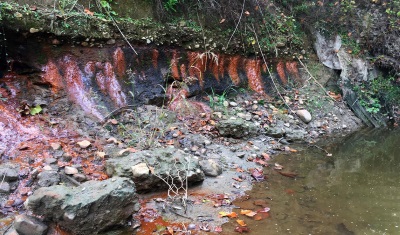Editor’s note: Watch this eight-minute video “Waiting for Disaster, Coal Ash on the Middle Fork.”
 American Rivers named the Middle Fork of the Vermilion River among America’s Most Endangered Rivers® of 2018, citing the threat toxic coal ash poses to Illinois’ only “Wild and Scenic River.” More than three million cubic yards of waste–from the coal-fired Vermilion Power Station–are sitting in three, unlined pits along the bank of the river. The plant’s owner, Dynegy, is seeking approval to cap and abandon the pits forever.
American Rivers named the Middle Fork of the Vermilion River among America’s Most Endangered Rivers® of 2018, citing the threat toxic coal ash poses to Illinois’ only “Wild and Scenic River.” More than three million cubic yards of waste–from the coal-fired Vermilion Power Station–are sitting in three, unlined pits along the bank of the river. The plant’s owner, Dynegy, is seeking approval to cap and abandon the pits forever.
“The coal ash pits were built irresponsibly close to the river,” said Mike Camp, local resident. “Making matters worse, natural river forces are eroding the riverbanks, so one huge flood could breach the pits tomorrow. Capping the pits won’t solve the problem. The only solution is to move the coal ash away from the river.”
The beautiful and ecologically vibrant Middle Fork of the Vermilion flows through the heart of Kickapoo State Park, which attracts over one million visitors each year. Flanked by nearly 10,000 acres of public land, the Middle Fork of the Vermilion is home to the blue breast darter and silvery salamander, as well as 22 other threatened or endangered species. An archeological site along the river’s east bank is listed on the National Register of Historic Places and includes 1000-year-old burial mounds.
In warm-weather months, thousands of visitors paddle a 13-mile river trail that passes directly by the coal ash pits….[They are unaware the pits] are leaching arsenic, barium, boron, chromium, iron, lead, manganese, molybdenum, nickel, and sulfate into the river. These contaminants are known to cause birth defects, cancer, and neurological damage in humans, and [they] can harm and kill wildlife, especially fish.
“This river changes people. There aren’t many ways to experience nature like this in Illinois,” said Andrew Rehn, Water Resources Engineer with Prairie Rivers Network. “The Middle Fork needs to be protected from coal ash, so that future generations can enjoy its scenic beauty.”
“This is a critical year for the people of this region to stand up for clean water and claim the kind of future they want for their river,” said David Moryc with American Rivers. “Now is the time to raise our voices and demand that Dynegy stop polluting this Wild and Scenic River and act to ensure the company’s coal ash pits do not pose a perpetual threat to the health of the Middle Fork or create a financial burden on taxpayers. This year marks the 50th anniversary of the Wild and Scenic Rivers Act. It’s time for the Illinois EPA and…Governor [Rauner] to listen, and ensure a positive legacy for future generations.”
“With recognition of the Middle Fork as one of America’s Most Endangered Rivers, the spotlight is now directly on the Governor and the Illinois EPA,” said Lan Richart, Co-Director of Eco-Justice Collaborative. “Will they require Dynegy to clean up their waste, or allow them to abandon the site and leave behind 3.3 million cubic yards of toxic ash for future generations?”
“I am pleased that this river is being recognized as an important resource,” said Michael Marron, Vermilion County Board Chairman. “The County is concerned about all of our resources, and that includes the Middle Fork River. It is an important part of our economy and recreation. We hope for any positive steps in maintaining them responsibly.”
Prairie Rivers Network (PRN) is Illinois’ advocate for clean water and healthy rivers and is the Illinois affiliate of the National Wildlife Federation. PRN advocates for cultural values, policies and practices that sustain the ecological health and biological diversity of Illinois’ water resources and aquatic ecosystems. It is a member-supported, nonprofit organization that champions clean, healthy rivers and lakes and safe drinking water to benefit the people and wildlife of Illinois.
American Rivers protects wild rivers, restores damaged rivers, and conserves clean water for people and nature. Since 1973, American Rivers has protected and restored more than 150,000 miles of rivers through advocacy efforts, on-the-ground projects, and an annual America’s Most Endangered Rivers® campaign. Headquartered in Washington, D. C., American Rivers has offices across the Country and more than 275,000 members, supporters, and volunteers. Rivers connect us to each other, nature, and future generations. Find your connections at AmericanRivers.org, Facebook.com/AmericanRivers, and Twitter.com/AmericanRivers.
